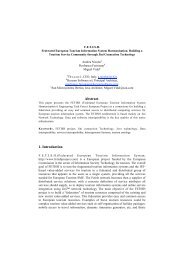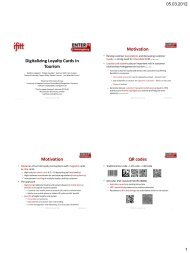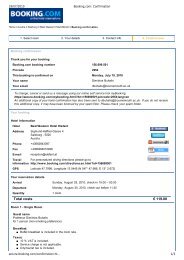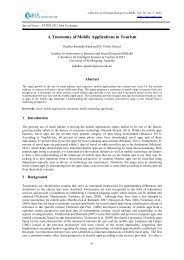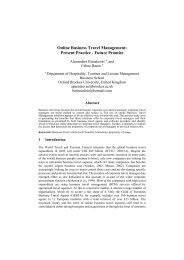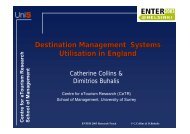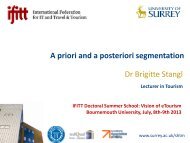What's in a Travel Review Title? Silvia De Ascaniis, Ulrike ... - IFITT
What's in a Travel Review Title? Silvia De Ascaniis, Ulrike ... - IFITT
What's in a Travel Review Title? Silvia De Ascaniis, Ulrike ... - IFITT
Create successful ePaper yourself
Turn your PDF publications into a flip-book with our unique Google optimized e-Paper software.
05.03.2012<br />
Problem<br />
Theoretical<br />
foundation<br />
Methodology<br />
Results<br />
What’s <strong>in</strong> a <strong>Travel</strong> <strong>Review</strong> <strong>Title</strong>?<br />
<strong>Silvia</strong> <strong>De</strong> <strong>Ascaniis</strong><br />
Webatelier.net<br />
Faculty of Communication Sciences<br />
University of Lugano - USI, Switzerland<br />
silvia.de.ascaniis@usi.ch<br />
Problem<br />
(Onl<strong>in</strong>e) Information search is a time<br />
consum<strong>in</strong>g activity people select onl<strong>in</strong>e<br />
resources on the base of a first impression of<br />
search results metadata (URL, date, title,<br />
etc.) are used to shape the first impression<br />
<strong>Ulrike</strong> Gretzel<br />
Institute for Innovation <strong>in</strong> Bus<strong>in</strong>ess and Social Research<br />
University of Wollongong, Australia<br />
ugretzel@uow.edu.au<br />
When select<strong>in</strong>g an Onl<strong>in</strong>e <strong>Travel</strong> <strong>Review</strong> (OTR),<br />
users might only browse through titles:<br />
are OTR titles representative of the<br />
respective texts?<br />
do they provide useful cues for OTR<br />
selection?<br />
ENTER 2012 Research Track Slide Number 1<br />
ENTER 2012 Research Track Slide Number 2<br />
Problem<br />
Theoretical<br />
foundation<br />
Methodology<br />
Results<br />
Problem<br />
Theoretical<br />
foundation<br />
Methodology<br />
Results<br />
Research Questions<br />
AIM: to <strong>in</strong>vestigate some basic features of OTR titles, i.e.:<br />
a. Length: can systematic differences <strong>in</strong> length be discovered<br />
based on certa<strong>in</strong> OTR characteristics?<br />
b. Informativeness: do OTR titles help the reader to figure out<br />
what the review is about?<br />
c. Orientation: do OTR titles with a +/- connotation correspond<br />
to reviews with a +/- rat<strong>in</strong>g?<br />
d. Diversity: how diverse is the <strong>in</strong>formation conta<strong>in</strong>ed <strong>in</strong> OTR<br />
titles, and which are the words and constructs most frequently<br />
used?<br />
e. Communicative function: which is the function of the title <strong>in</strong><br />
the review economy?<br />
ENTER 2012 Research Track Slide Number 3<br />
Theoretical foundations<br />
A review is a specific textual genre hav<strong>in</strong>g its<br />
proper characteristics, which are determ<strong>in</strong>ed by its<br />
<strong>in</strong>tended function.<br />
Indications given by<br />
the onl<strong>in</strong>e platform<br />
Author’s motivations<br />
for writ<strong>in</strong>g a review<br />
Every communicative act is produced to address an<br />
<strong>in</strong>terlocutor<br />
the general reason for writ<strong>in</strong>g a review is for it to be read!<br />
“I would like to know<br />
which attractions <strong>in</strong><br />
Sydney are worth a visit. I<br />
will look at a couple of<br />
onl<strong>in</strong>e reviews!”<br />
Which communicative strategies are used by the authors of<br />
OTRs to make their texts attractive for an unknown audience?<br />
ENTER 2012 Research Track Slide Number 4<br />
1
05.03.2012<br />
Problem<br />
Theoretical<br />
foundation<br />
Theoretical foundation<br />
Role of headl<strong>in</strong>es <strong>in</strong> newspapers:<br />
‣ to catch readers’ curiosity and<br />
provoke them to go on read<strong>in</strong>g<br />
Methodology<br />
‣ to help readers receive the best deal<br />
of <strong>in</strong>formation with the least cognitive<br />
effort<br />
Results<br />
ROLE OF TITLES IN OTR<br />
Role of tagl<strong>in</strong>es <strong>in</strong> advertisements:<br />
‣ to catch consumers’ attention<br />
‣ to create the first impression of the<br />
product<br />
‣ to make consumers remember the<br />
product<br />
‣ anticipate someth<strong>in</strong>g about the text<br />
‣ arouse readers’ <strong>in</strong>terest<br />
ENTER 2012 Research Track Slide Number 5<br />
Problem<br />
Theoretical<br />
foundation<br />
Data Corpus<br />
• <strong>Review</strong>s from TripAdvisor.com<br />
• report<strong>in</strong>g experiences at three big city dest<strong>in</strong>ations<br />
• collected until September 3 rd , 2011<br />
Total N° of reviews <strong>in</strong> the <strong>Travel</strong> Guide<br />
section<br />
Rome Sydney Paris Total<br />
9734 2231 10084 22049<br />
N° of reviews <strong>in</strong> the “dest<strong>in</strong>ation group” 1012 240 887 2139<br />
N° of reviews after the filter<strong>in</strong>g 701 173 600 1474<br />
% of tot<br />
N°<br />
<strong>Review</strong>s <strong>in</strong> English 470 109 345 924 62.7%<br />
<strong>Review</strong>s <strong>in</strong> German 134 52 119 305 20.7%<br />
<strong>Review</strong>s <strong>in</strong> French 33 0 46 79 5.4%<br />
<strong>Review</strong>s <strong>in</strong> Italian 64 12 90 166 11.3%<br />
N° of reviews with rat<strong>in</strong>g 4 (very good) or<br />
5 (excellent)<br />
589 169 504 1262 85.6%<br />
N° of reviews with rat<strong>in</strong>g 3 (average) 34 3 46 83 5.6%<br />
N° of reviews with rat<strong>in</strong>g 2 (poor) or 1<br />
(terrible)<br />
Methodology<br />
Results<br />
78 1 50 129 8.8%<br />
ENTER 2012 Research Track Slide Number 6<br />
Problem<br />
Theoretical<br />
foundation<br />
Methodology<br />
Results<br />
Problem<br />
Theoretical<br />
foundation<br />
Methodology<br />
Results<br />
Classification criteria:<br />
Cod<strong>in</strong>g procedure<br />
‣ Rat<strong>in</strong>g = the overall rat<strong>in</strong>g provided by the review author for the<br />
dest<strong>in</strong>ation: 1 = terrible, 2 = poor, 3 = average, 4 = very good, 5 = excellent<br />
‣ Language = English, German, French, Italian.<br />
Methodology – Analysis<br />
UAM Corpus Tool<br />
= a software for human and semi-automatic annotation of texts and images.<br />
It allows to explore l<strong>in</strong>guistic patterns and l<strong>in</strong>guistic features <strong>in</strong> a text.<br />
‣ Connotation = the overall orientation of the title: positive, negative, notapplicable<br />
(the title was not univocally polarized or was ambiguously<br />
formulated), neutral (the title had not any recognizable evaluative connotation)<br />
Manual cod<strong>in</strong>g, because:<br />
- semantic nuances needed to be caught<br />
- coders were representative of actual Internet users<br />
ENTER 2012 Research Track Slide Number 7<br />
ENTER 2012 Research Track Slide Number 8<br />
2
05.03.2012<br />
Problem<br />
Theoretical<br />
foundation<br />
Methodology<br />
Results<br />
Problem<br />
Theoretical<br />
foundation<br />
Methodology<br />
Results<br />
Average length = 4.4 words per title<br />
maximum length =17 words<br />
Average<br />
length<br />
Positive<br />
connotation<br />
(tot.<br />
887/1474)<br />
Negative<br />
connotation<br />
(tot.<br />
143/1474)<br />
LENGTH<br />
Neutral<br />
(tot.<br />
143/1474)<br />
Notapplicable<br />
(94/1474)<br />
Rome Paris Sydney<br />
4.4 4.9 3.8 5.4 4.5 4.3 4.4<br />
INFORMATIVENESS<br />
Lexical <strong>De</strong>nsity = a measure of the density of <strong>in</strong>formation <strong>in</strong> any passage of text,<br />
accord<strong>in</strong>g to how tightly the lexical items (e.g. nouns, verbs) have been packed <strong>in</strong>to the<br />
grammatical structure:<br />
‣ measured as the number of lexical items (Nlex) divided by the total number of words<br />
per clause (N): Ld = (Nlex / N) x100<br />
‣ LD of spoken language tends to be lower than that of written language<br />
‣ LD varies from language to language, UAM Corpus Tool limited to English<br />
Average N°<br />
of words<br />
Positive Negative<br />
rat<strong>in</strong>g rat<strong>in</strong>g<br />
(1262/1474) (129/1474)<br />
4.3 4.6 4.6<br />
Average<br />
rat<strong>in</strong>g<br />
(83/1474)<br />
Less words are used for <strong>in</strong>troduc<strong>in</strong>g a<br />
positive experience at a dest<strong>in</strong>ation than<br />
for depict<strong>in</strong>g a negative or average<br />
impression negative judgments need<br />
to be conv<strong>in</strong>c<strong>in</strong>gly supported<br />
LD per English title =65% nearly 3 out of 5 words are words which<br />
communicate univocal <strong>in</strong>formation (42% <strong>in</strong> normal written English)<br />
ENTER 2012 Research Track Slide Number 9<br />
ENTER 2012 Research Track Slide Number 10<br />
Problem<br />
Theoretical<br />
foundation<br />
Methodology<br />
Results<br />
Problem<br />
Theoretical<br />
foundation<br />
Methodology<br />
Results<br />
<strong>Review</strong> rat<strong>in</strong>g<br />
REVIEW ORIENTATION<br />
<strong>Title</strong> Connotation<br />
Positive Neutral Not-applicable Negative<br />
4 (very good) or 5 (excellent) 98.0% 87.7% 68.1% 14.7%<br />
3 (average) 1.2% 7.4% 16.0% 63.0%<br />
1 (terrible) or 2 (poor) 0.8% 4.9% 16.0% 22.4%<br />
MOST FREQUENT WORDS<br />
Token Total frequency Rome Sydney Paris<br />
City/Stadt/città/ville 324 147 49 128<br />
Rome/Rom/Roma 316 316 0 0<br />
Paris/Parigi 288 0 0 288<br />
Amaz<strong>in</strong>g/great/wonderful/toll 93 50 16 27<br />
Beautiful/schöne/bella/belle 64 44 10 20<br />
Sydney 62 0 62 0<br />
<strong>Title</strong>s with positive connotations are significantly l<strong>in</strong>ked to reviews with<br />
positive rat<strong>in</strong>gs and titles with negative connotations only somewhat<br />
correspond to reviews with negative rat<strong>in</strong>gs.<br />
<strong>Title</strong>s often refer to the dest<strong>in</strong>ation.<br />
ENTER 2012 Research Track Slide Number 11<br />
ENTER 2012 Research Track Slide Number 12<br />
3
05.03.2012<br />
Problem<br />
Theoretical<br />
foundation<br />
Methodology<br />
Results<br />
Problem<br />
Theoretical<br />
foundation<br />
Methodology<br />
Results<br />
WORD DIVERSITY<br />
Token Total frequency Rome Sydney Paris<br />
Amaz<strong>in</strong>g/great/wonderful/toll 93 50 16 27<br />
Beautiful/schöne/bella/belle 64 44 10 20<br />
World/welt/mondo/monde 57 22 22 13<br />
Favorite/favourite 55 27 7 21<br />
Eternal/ewige/eternelle/eterna 43 43 0 0<br />
Love/liebe/amour/amore 41 11 0 30<br />
Trip 37 17 2 18<br />
Visit 32 19 4 9<br />
Tour 32 10 3 19<br />
Romantic/romatisch/romantica 27 8 0 19<br />
Time 22 12 5 5<br />
frequency counts are very low, suggest<strong>in</strong>g a great diversity of words be<strong>in</strong>g used <strong>in</strong> the titles<br />
strong use of superlatives and slogans persuasive reason<br />
positive words much more frequent than negative ones<br />
highlight one of the dest<strong>in</strong>ation features<br />
meta-words perta<strong>in</strong><strong>in</strong>g to the experience of travell<strong>in</strong>g<br />
ENTER 2012 Research Track Slide Number 13<br />
COMMUNICATIVE FUNCTIONS<br />
They were <strong>in</strong>vestigated observ<strong>in</strong>g the representativeness of lexical patterns, specifically:<br />
- temporal nouns and temporal adverbs to give temporal <strong>in</strong>dications (e.g. “Rome <strong>in</strong><br />
w<strong>in</strong>ter”, “Paris <strong>in</strong> 3 days”);<br />
- evaluative adjectives to evaluate or describe the tourism experience (“Great city”,<br />
“Romantic Paris”);<br />
- comparative adjectives to express expectations (e.g. “Better than expected”)<br />
- personal pronouns to give personal judgments (e.g. “We loved Rome!”) or<br />
recommendations (“Go to Paris!”)<br />
descriptive words are much more common than comparative words or words that<br />
suggest a direct advice addressed to the reader<br />
1st person pronouns are more common than 2nd person pronouns, <strong>in</strong>dicat<strong>in</strong>g that<br />
most titles represent a summary statement of a personal experience or a general<br />
dest<strong>in</strong>ation description<br />
ENTER 2012 Research Track Slide Number 14<br />
SUMMARY<br />
• OTR titles are short, lexically dense statements<br />
that often <strong>in</strong>clude the dest<strong>in</strong>ation name but also a<br />
diversity of other words.<br />
• They mostly summarize personal experiences.<br />
• Positive titles are shorter; titles <strong>in</strong>troduc<strong>in</strong>g<br />
positive reviews are also shorter.<br />
• Positive OTR titles are l<strong>in</strong>ked to positively rated<br />
reviews. The correspondence is not given for<br />
negative titles.<br />
IMPLICATIONS<br />
• OTR titles should be <strong>in</strong>cluded <strong>in</strong> social media<br />
monitor<strong>in</strong>g/academic research.<br />
• Confirmed previous f<strong>in</strong>d<strong>in</strong>gs of misalignment<br />
between negative reviews and review rat<strong>in</strong>gs.<br />
• <strong>Review</strong> platforms need to recognize importance of<br />
titles and provide better <strong>in</strong>structions.<br />
• Could be used for review fast, automatic review<br />
classifications.<br />
ENTER 2012 Research Track Slide Number 15<br />
ENTER 2012 Research Track Slide Number 16<br />
4
05.03.2012<br />
FUTURE RESEARCH<br />
• Should be compared to advertis<strong>in</strong>g slogans/<br />
tagl<strong>in</strong>es of the dest<strong>in</strong>ations.<br />
• Need more research on negative argumentation<br />
• Need to explore further concessive statements<br />
(but, if).<br />
• Widen scope <strong>in</strong> terms of dest<strong>in</strong>ations and<br />
languages.<br />
ENTER 2012 Research Track Slide Number 17<br />
5






